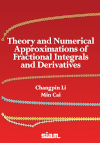- About MAA
- Membership
- MAA Publications
- Periodicals
- Blogs
- MAA Book Series
- MAA Press (an imprint of the AMS)
- MAA Notes
- MAA Reviews
- Mathematical Communication
- Information for Libraries
- Author Resources
- Advertise with MAA
- Meetings
- Competitions
- Programs
- Communities
- MAA Sections
- SIGMAA
- MAA Connect
- Students
- MAA Awards
- Awards Booklets
- Writing Awards
- Teaching Awards
- Service Awards
- Research Awards
- Lecture Awards
- Putnam Competition Individual and Team Winners
- D. E. Shaw Group AMC 8 Awards & Certificates
- Maryam Mirzakhani AMC 10 A Awards & Certificates
- Two Sigma AMC 10 B Awards & Certificates
- Jane Street AMC 12 A Awards & Certificates
- Akamai AMC 12 B Awards & Certificates
- High School Teachers
- News
You are here
Theory and Numerical Approximations of Fractional Integrals and Derivatives

Publisher:
SIAM
Publication Date:
2019
Number of Pages:
312
Format:
Paperback
Price:
89.00
ISBN:
978-1-61197-587-1
Category:
Monograph
[Reviewed by , on ]
Bill Satzer
02/13/2022
The fractional calculus, with its fractional derivatives and integrals, goes back as far as Leibnitz. Up until about 1970 it was at most a peripheral topic. In the years since 1970 the number of publications using the fractional calculus has grown enormously.
Interest in the subject is driven in part by applications in physics and biology. One of the main application areas has been in anomalous diffusion and related transport problems. The fractional calculus creates derivatives that are not local and are capable of incorporating memory.
A significant obstacle to learning how to use fractional derivatives and integrals is that there are a huge number of essentially non-equivalent formulations. One of the purposes of the first part of this book is to identify the primary variations and to describe the relationships between them. In this book fractional derivatives of Riemann-Liouville, Caputo and Riesz type are treated at some length, as is the fractional Laplacian. Three more variations are described briefly.
Fractional calculus also offers challenges to our usual intuitions. For example, the Riemann-Liouville 1/2-order derivative of the constant function \( f(x)=1 \) is not zero, and the derivatives of order \( 1/2 \) for \( \sin(x) \) and \( \cos(x) \) involve a Fresnel integral.
Most of the rest of the book after the introductory chapters presents numerical methods for evaluating fractional integrals and derivatives. The authors claim to have included nearly all the existing results for numerical approximations of this kind. Detailed derivations are provided for many of these. The last chapter uses an example of a one-dimensional continuous-time random walk model to show its physical interpretation and how the integral definition of the fractional Laplacian emerges.
This is a comprehensive text; it is detailed, complete and intense – aimed at specialists and those wishing to get deep into the subject.
Bill Satzer (bsatzer@gmail.com), now retired from 3M Company, spent most of his career as a mathematician working in industry on a variety of applications. He did his PhD work in dynamical systems and celestial mechanics.
See the publisher's website.
- Log in to post comments




